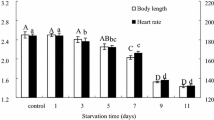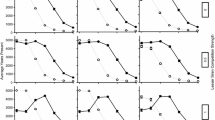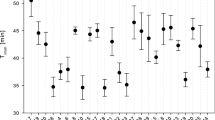Summary
Models incorporating the energetics of individual daphnids (Cladocera) have been developed to predict the effect of environmental variables, particularly food availability, on population dynamics. One of them, that of Kooijman (1986), assumes that all assimilated energy enters a storage compartment prior to use in production and metabolism, and that under starvation the stores are used to support maintenance, reproduction and somatic growth, in that order of priority. This predicts that, under starvation, reproduction and growth will continue for a time, and that after they cease death will be immediate. Another model, that of McCauley et al. (1990), assumes that assimilated energy is used directly for maintenance and production, and that stores are accumulated to support maintenance metabolism under starvation. This predicts that growth and reproduction should cease immediately upon starvation and that death will not be immediate. We have carried out laboratory experiments, manipulating starvation time, on Daphnia magna to distinguish between these two models. The results support features of both models in that reproduction, but not growth, ceases upon starvation. We therefore developed a third model in which both maintenance and growth are supported from stores under starvation, with maintenance taking priority over growth under these conditions.
Similar content being viewed by others
References
ASTM (1980) Standard practise for conducting acute toxicity tests with fishes, macroinvertebrates and amphibians E-729-90. American Standards for Testing and Materials. Philadelphia, P.A.
Baird DJ, Soares AMVM, Girling A, Barber I, Bradley M, Calow P (1989) The long-term maintenance of Daphnia magna Straus for use in ecotoxicity tests: problems and prospects. In: Lokke H, Bro-Rasmussen F (eds) Proceedings of the 1st European conference on ecotoxicology, Copenhagen 1988. Conference Organising Committe, Lyngby (Denmark), pp 144–148
Bradley MC, Baird DJ, Calow P (1990) Mechanisms of energy allocation to reproduction in the cladoceran Daphnia magna Straus (in press)
Kooijman SALM (1986) Population dynamics on the basis of budgets. In: Metz JAJ, Diekman O (eds) The dynamics of physiologically structured populations. Springer, Berlin Heidelberg New York, pp 266–297
McCauley E, Murdoch WW, Nisbet RM, Gurney WSC (1990) The physiological ecology of Daphnia: Development of a model of growth and reproduction. Ecology 71:703–715
Stein JR (1973) Handbook of phycological methods-culture methods and growth measurements. Cambridge University Press, Cambridge, U.K.
Threlkeld ST (1979) Estimating cladoceran birth rates: the importance of egg mortality and egg age distribution. Limnol Oceanogr 24:601–612
Author information
Authors and Affiliations
Rights and permissions
About this article
Cite this article
Bradley, M.C., Perrin, N. & Calow, P. Energy allocation in the cladoceran Daphnia magna Straus, under starvation and refeeding. Oecologia 86, 414–418 (1991). https://doi.org/10.1007/BF00317610
Received:
Accepted:
Issue Date:
DOI: https://doi.org/10.1007/BF00317610




